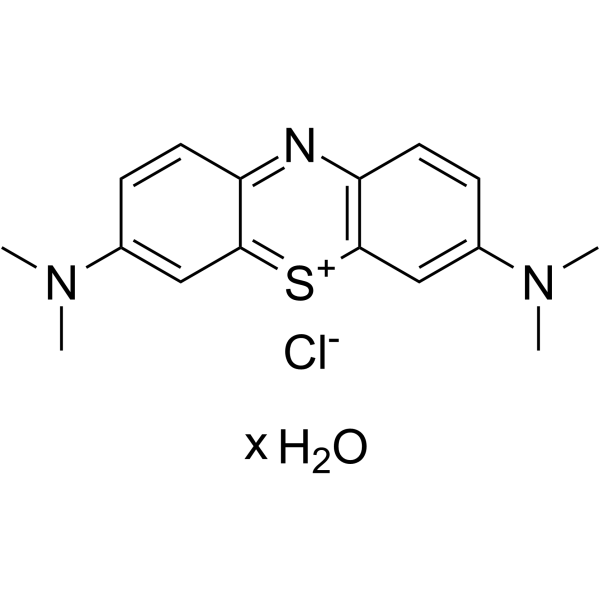122965-43-9
| Name | methylene blue |
|---|---|
| Synonyms |
Methylene Blue hydrate,high purity biological stain
MFCD00150006 Methylene Blue,high purity Methylene Blue MethyleneblueHydrat Methylene Blue hydrate Methylthioninium chloride EINECS 200-515-2 Methylene Blue hydrate,Methylthionini chloridum |
| Description | Methylene blue (Basic Blue 9) hydrate is a guanylyl cyclase (sGC), monoamine oxidase A (MAO-A) and NO synthase (NOS) inhibitor. Methylene blue is a vasopressor and is often used as a dye in several medical procedures. Methylene blue hydrate through the nitric oxide syntase/guanylate cyclase signalling pathway to reduce prepulse inhibition. Methylene blue hydrate is a REDOX cycling compound and able to cross the blood-brain barrier. Methylene blue hydrate is a Tau aggregation inhibitor. Methylene blue hydrate reduces cerebral edema, attenuated microglial activation and reduced neuroinflammation[1][2][3]. |
|---|---|
| Related Catalog | |
| In Vitro | Methylene blue (Basic Blue 9) hydrate (4.5 μM; BV2 microglia) alters the immune profile of LPS-activated BV2 microglia and decreased the level of CD14, IL-1β, TNF-α, and CCL2 mRNA[3]. |
| In Vivo | Methylene blue (Basic Blue 9) hydrate (50 and 100 mg/kg; i.p.; once, for 25 min; male NMRI mice) reduces absent prepulse inhibition[1]. Methylene blue (Basic Blue 9) hydrate (20 and 40 mg/kg; p.o.; daily, for 6 months; CaMKIIα-tTA transactivator mice) preserves cognition in mice expressing full-length pro-aggregant human Tau[2]. Methylene blue (Basic Blue 9) hydrate (2 mg/kg; i.v.; once, for 1 d; TBI-treated male BALB/c mice) reduces TBI-induced edema and neuroinflammation and reduces acute depression-like behavior[3]. Methylene blue (Basic Blue 9) hydrate (2 mg/kg; i.v.; once, for 1 d; TBI-treated male BALB/c mice) reduces the percentage of inflammatory factor[3]. Animal Model: Male NMRI mice[1] Dosage: 50 and 100 mg/kg Administration: Intraperitoneal injection; once, for 25 minutes Result: Reduced the prepulse inhibition and reduced the increase in locomotor activity caused by phencyclidine (PCP). Animal Model: CaMKIIα-tTA transactivator mice[2] Dosage: 20 and 40 mg/kg Administration: Oral administration; daily, for 6 months Result: Inhibited Tau aggregation in CaMKIIα-tTA transactivator mice. Animal Model: TBI-treated male BALB/c mice[3] Dosage: 2 mg/kg Administration: Intravenous injection; once, for 1 day Result: Decreased the level of CD14, IL-1β, TNF-α, and CCL2 mRNA. Animal Model: TBI-treated male BALB/c mice[3] Dosage: 2 mg/kg Administration: Intravenous injection; once, for 1 day Result: Reduced the percentage of myeloid (CD11b+/GR1+) cells, reduced IL-1β and enhanced IL-10 expression in microglia. |
| References |
| Density | 0.6600g/ml |
|---|---|
| Melting Point | 190ºC |
| Molecular Formula | C16H20ClN3OS |
| Molecular Weight | 337.86800 |
| Exact Mass | 337.10200 |
| PSA | 56.61000 |
| Appearance | Fine Crystalline Powder | Green |
| Storage condition | room temp |
| Water Solubility | H2O: soluble4mg/4ml | Soluble in water, alcohol, acetic acid, glycerol and chloroform. Insoluble in ether. |
| Symbol |

GHS07 |
|---|---|
| Signal Word | Warning |
| Hazard Statements | H302 |
| Precautionary Statements | P301 + P312 + P330 |
| Personal Protective Equipment | dust mask type N95 (US);Eyeshields;Gloves |
| Hazard Codes | Xn:Harmful |
| Risk Phrases | R22 |
| Safety Phrases | 26-39-61 |
| RIDADR | UN 2811 6.1/PG 3 |
| WGK Germany | 3 |
| RTECS | SO5600000 |


